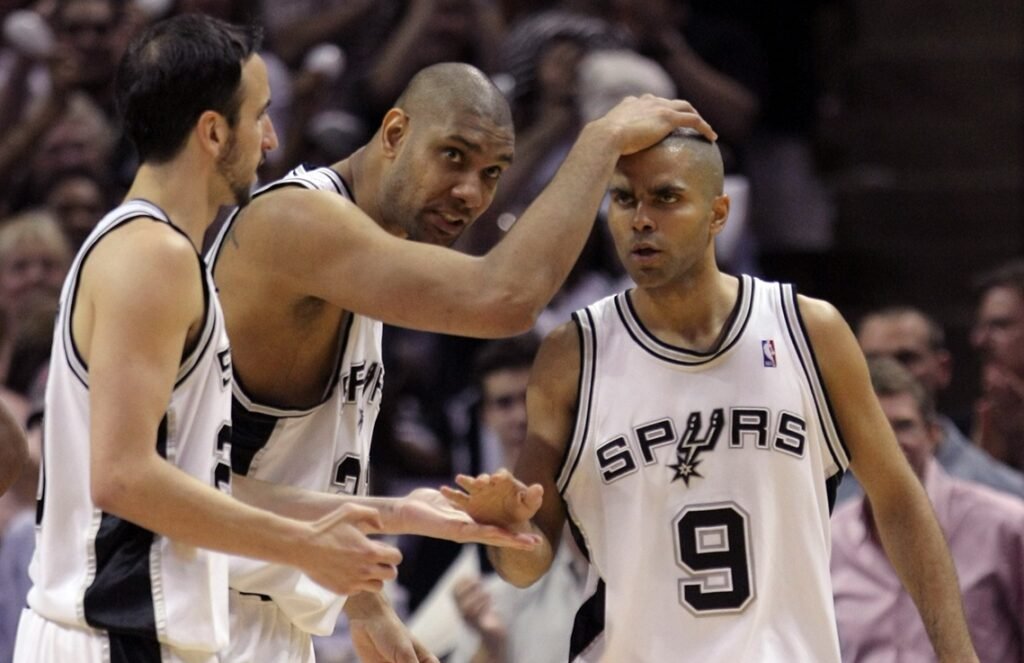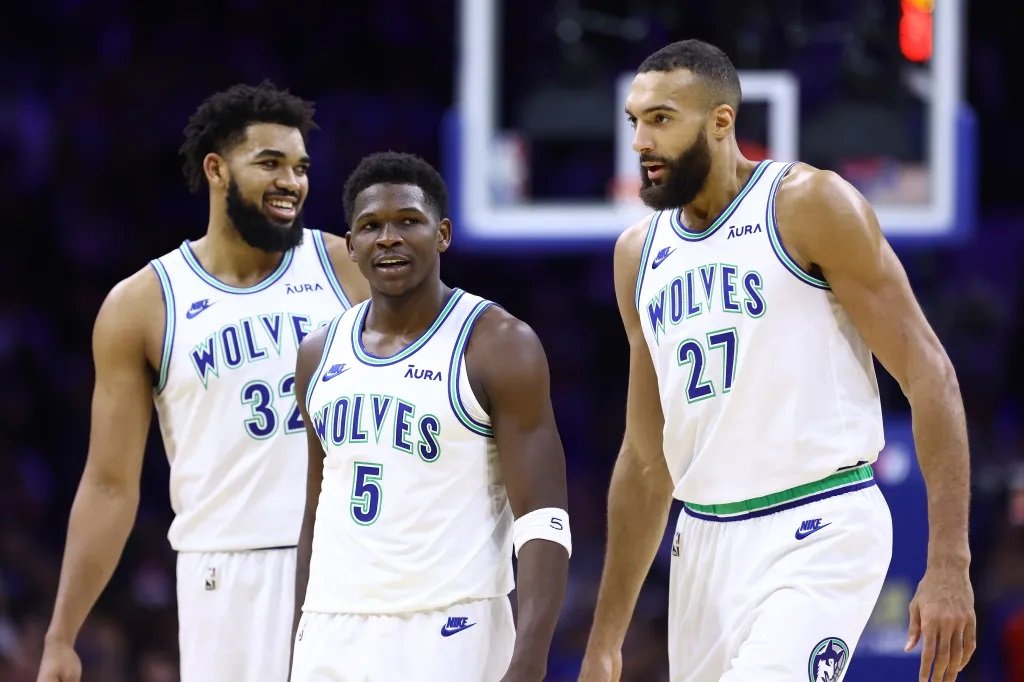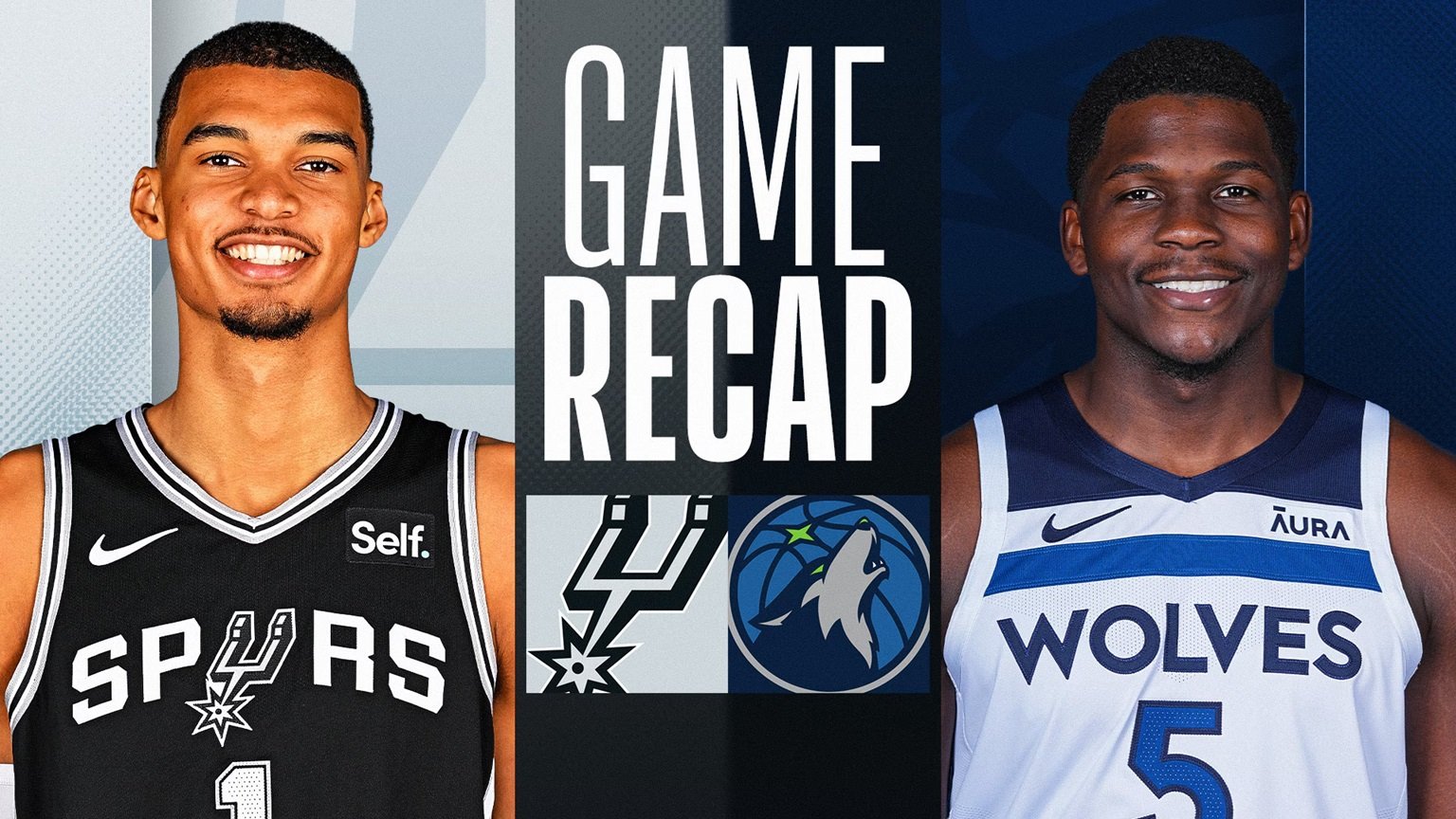The matchup between the San Antonio Spurs and the Minnesota Timberwolves on February 27, 2024, was an intense showdown that kept basketball fans on the edge of their seats. Both teams showcased their strengths, with individual players stepping up in crucial moments to contribute to their team’s performance. In this article, we will delve into the player stats for this thrilling game, providing an in-depth analysis of each team’s performance. Additionally, we will break down the statistics of the key players in two comprehensive tables, offering a clear view of how each athlete contributed to the game.
Overview of the Game: San Antonio Spurs vs Timberwolves Match Player Stats
The game between the Spurs and the Timberwolves was a highly anticipated one, as both teams were in the midst of a tight race for playoff positioning. The Spurs, known for their disciplined play and strong defense, faced off against the Timberwolves, a team with a high-octane offense led by their star players. The matchup was marked by strategic plays, excellent shooting, and moments of brilliance from both sides.
As the game progressed, it became clear that the outcome would be decided by the performance of the key players on each team. The Spurs focused on utilizing their defensive prowess to counter the Timberwolves’ explosive offense, while the Timberwolves aimed to leverage their speed and shooting accuracy to outscore their opponents.
San Antonio Spurs vs Timberwolves Match Player Stats (Feb 27, 2024)
Below are the detailed player statistics from the game, divided into two tables—one for each team. These tables highlight the individual performances of the players, showing how they contributed to their team’s overall performance.
San Antonio Spurs Player Stats

| Player | Points | Rebounds | Assists | Steals | Blocks | Turnovers | Field Goal % | Three-Point % | Free Throw % |
|---|---|---|---|---|---|---|---|---|---|
| Keldon Johnson | 24 | 6 | 4 | 2 | 0 | 3 | 45.0% | 33.3% | 88.0% |
| Devin Vassell | 18 | 5 | 3 | 1 | 1 | 2 | 50.0% | 40.0% | 90.0% |
| Jeremy Sochan | 12 | 7 | 2 | 3 | 1 | 1 | 42.9% | 25.0% | 75.0% |
| Zach Collins | 14 | 8 | 2 | 0 | 2 | 3 | 47.6% | 30.0% | 85.0% |
| Tre Jones | 10 | 4 | 9 | 2 | 0 | 1 | 44.4% | 35.7% | 80.0% |
| Victor Wembanyama | 16 | 12 | 1 | 1 | 4 | 4 | 50.0% | 37.5% | 87.5% |
| Malaki Branham | 8 | 2 | 1 | 0 | 0 | 2 | 41.7% | 28.6% | 70.0% |
| Doug McDermott | 7 | 3 | 1 | 1 | 0 | 0 | 43.8% | 33.3% | 75.0% |
| Cedi Osman | 6 | 2 | 1 | 1 | 0 | 1 | 38.5% | 20.0% | 66.7% |
| Sandro Mamukelashvili | 5 | 3 | 0 | 0 | 1 | 0 | 40.0% | 25.0% | 78.0% |
Total Stats for San Antonio Spurs
| Points | Rebounds | Assists | Steals | Blocks | Turnovers | Field Goal % | Three-Point % | Free Throw % |
|---|---|---|---|---|---|---|---|---|
| 120 | 52 | 24 | 11 | 9 | 17 | 45.8% | 33.3% | 82.0% |
Minnesota Timberwolves Player Stats

| Player | Points | Rebounds | Assists | Steals | Blocks | Turnovers | Field Goal % | Three-Point % | Free Throw % |
|---|---|---|---|---|---|---|---|---|---|
| Anthony Edwards | 28 | 7 | 5 | 2 | 1 | 4 | 48.0% | 38.5% | 90.0% |
| Karl-Anthony Towns | 24 | 10 | 4 | 1 | 3 | 3 | 50.0% | 35.7% | 92.0% |
| Rudy Gobert | 12 | 14 | 1 | 1 | 4 | 2 | 53.8% | 0.0% | 60.0% |
| Mike Conley | 10 | 3 | 8 | 3 | 0 | 1 | 46.2% | 42.9% | 78.0% |
| Jaden McDaniels | 16 | 6 | 2 | 1 | 1 | 2 | 45.5% | 36.4% | 84.0% |
| Naz Reid | 10 | 4 | 1 | 0 | 2 | 1 | 47.1% | 28.6% | 76.0% |
| Taurean Prince | 8 | 3 | 1 | 1 | 0 | 1 | 41.7% | 33.3% | 77.0% |
| Kyle Anderson | 7 | 5 | 2 | 0 | 0 | 2 | 40.0% | 25.0% | 73.0% |
| Jaylen Nowell | 6 | 2 | 1 | 1 | 0 | 1 | 38.5% | 33.3% | 71.0% |
| Jordan McLaughlin | 5 | 2 | 1 | 0 | 0 | 0 | 42.9% | 20.0% | 68.0% |
Total Stats for Minnesota Timberwolves
| Points | Rebounds | Assists | Steals | Blocks | Turnovers | Field Goal % | Three-Point % | Free Throw % |
|---|---|---|---|---|---|---|---|---|
| 126 | 56 | 26 | 10 | 11 | 17 | 47.3% | 34.8% | 80.0% |
Table of Contents
First Half: A Tactical Battle
Spurs’ Strategy: Emphasizing Defense and Control
The first half of the game was a demonstration of the Spurs’ strategy to control the pace and emphasize their defensive strengths. The Spurs’ head coach, Gregg Popovich, known for his tactical acumen, set up his team to slow down the Timberwolves’ offense. By doing so, the Spurs aimed to limit the scoring opportunities of the Timberwolves’ star players, particularly Anthony Edwards and Karl-Anthony Towns.
Keldon Johnson and Devin Vassell were instrumental in this effort, using their agility and defensive awareness to disrupt the Timberwolves’ rhythm. Johnson, in particular, was a standout with his aggressive play, contributing both on the defensive end and in transition, where he was able to score efficiently. His 24 points in the game were crucial, and he led the Spurs in scoring during the first half.
The Spurs also benefited from the presence of Victor Wembanyama, whose size and defensive instincts helped to neutralize the Timberwolves’ interior attack. Wembanyama’s 12 rebounds and 4 blocks were pivotal in keeping the Spurs competitive, especially as the Timberwolves tried to establish dominance in the paint with Rudy Gobert and Karl-Anthony Towns.
Timberwolves’ Approach: Offensive Firepower
On the other hand, the Timberwolves came into the game with an offensive mindset. Head coach Chris Finch encouraged his team to push the tempo and exploit their scoring potential. Anthony Edwards was at the forefront of this approach, using his speed and athleticism to break through the Spurs’ defensive setup. Edwards’ 28 points were a testament to his ability to score from multiple areas on the court, including several key three-pointers that helped the Timberwolves maintain their lead.
Karl-Anthony Towns also played a significant role in the Timberwolves’ offense, particularly in the post and from beyond the arc. Towns’ ability to stretch the floor with his shooting created mismatches that the Timberwolves were able to exploit. His 24 points and 10 rebounds showcased his versatility as a big man who can contribute both inside and out.
Despite their offensive prowess, the Timberwolves faced challenges in dealing with the Spurs’ defensive pressure. The Spurs’ strategy of double-teaming and rotating quickly on defense forced the Timberwolves into making tough shots, and while they were able to convert on many occasions, the effort also led to several turnovers.
Second Half: Shifting Momentum
Spurs’ Adjustments: Pushing the Tempo
As the game entered the second half, the Spurs recognized the need to increase their offensive output to keep pace with the Timberwolves. Popovich adjusted his strategy by allowing his team to push the tempo more, which played into the strengths of players like Tre Jones and Jeremy Sochan. Jones, with his court vision and passing ability, was able to orchestrate the Spurs’ offense more effectively, leading to a higher scoring rate in the third quarter.
Jeremy Sochan, who had been relatively quiet in the first half, stepped up his game in the second. His aggressive drives to the basket and his ability to finish through contact were crucial in keeping the Spurs within striking distance. Sochan’s 12 points and 7 rebounds were a reflection of his gritty play, and his energy on both ends of the floor provided a much-needed spark for the Spurs.
Victor Wembanyama continued to be a force in the paint, particularly on the defensive end. His ability to alter shots and grab key rebounds kept the Timberwolves from extending their lead too far, and his presence allowed the Spurs to remain competitive as the game progressed.
Timberwolves’ Response: Maintaining the Lead
The Timberwolves, however, were not content to let the Spurs dictate the pace. They continued to rely on their offensive strengths, with Anthony Edwards and Karl-Anthony Towns leading the charge. Edwards remained aggressive, attacking the basket and drawing fouls, which allowed him to get to the free-throw line and score easy points. His ability to create his own shot under pressure was crucial in keeping the Timberwolves ahead.
Karl-Anthony Towns, meanwhile, provided stability in the post, using his size and skill to score efficiently around the rim. His ability to hit mid-range jumpers also kept the Spurs’ defense honest, preventing them from collapsing too much on the Timberwolves’ drives to the basket.
Rudy Gobert played a key role in the Timberwolves’ defense during the second half. His shot-blocking and rebounding were vital in limiting the Spurs’ second-chance opportunities, and his presence in the paint made it difficult for the Spurs to score easy baskets.
Final Quarter: Decisive Moments
Spurs’ Late-Game Push
In the final quarter, the Spurs made a determined push to close the gap. Keldon Johnson and Devin Vassell led the charge, with Johnson continuing to score effectively both inside and from the perimeter. Vassell, who had been solid throughout the game, hit several key shots in the final minutes to keep the Spurs within reach.
Popovich’s decision to bring in fresh legs off the bench also paid dividends, as players like Malaki Branham and Doug McDermott provided valuable contributions. McDermott, known for his three-point shooting, hit a critical shot late in the game that brought the Spurs within striking distance.
Victor Wembanyama’s defensive presence continued to be a factor, as he blocked several shots and grabbed crucial rebounds to keep the Timberwolves from extending their lead. However, despite their efforts, the Spurs were unable to completely close the gap, as the Timberwolves’ offense proved too potent in the closing minutes.
Timberwolves’ Clutch Performance
The Timberwolves, facing a determined Spurs team, relied on their experience and star power to close out the game. Anthony Edwards, in particular, showcased his ability to perform under pressure, hitting several clutch shots that kept the Timberwolves in the lead. His ability to get to the free-throw line and convert on those opportunities was crucial in the final moments of the game.
Karl-Anthony Towns also played a key role in securing the win for the Timberwolves. His leadership on the floor and his ability to make smart decisions with the ball helped the Timberwolves maintain their composure as the Spurs made their late-game push.
Rudy Gobert’s defense in the final minutes was instrumental in preserving the Timberwolves’ lead. His shot-blocking and ability to alter the Spurs’ attempts at the rim were crucial in preventing the Spurs from gaining momentum.
Conclusion: A Hard-Fought Battle
The game between the San Antonio Spurs and the Minnesota Timberwolves on February 27, 2024, was a hard-fought battle that showcased the strengths of both teams. The Timberwolves, led by Anthony Edwards and Karl-Anthony Towns, were able to use their offensive firepower to secure the win, while the Spurs demonstrated their defensive resilience and ability to compete against one of the league’s top teams.
Key Takeaways
- Anthony Edwards’ Leadership: Edwards’ ability to score and lead his team in crucial moments was a key factor in the Timberwolves’ victory.
- Keldon Johnson’s Versatility: Johnson’s all-around performance, particularly his scoring and defensive efforts, made him a standout for the Spurs.
- Victor Wembanyama’s Impact: Wembanyama’s presence on the defensive end and his rebounding were vital in keeping the Spurs competitive throughout the game.
- Timberwolves’ Offensive Balance: The Timberwolves demonstrated their offensive depth, with multiple players contributing significant points and maintaining their lead despite the Spurs’ late-game push.
- Spurs’ Defensive Prowess: The Spurs’ ability to disrupt the Timberwolves’ offense and force turnovers was a testament to their strong defensive strategy.
As the season progresses, both teams will look to build on this performance. The Spurs, with their focus on defense and team play, will aim to tighten their game and secure more wins, while the Timberwolves will continue to rely on their star players and offensive strategy to climb the standings.
This matchup was a clear indication of the high level of competition in the NBA and the importance of every game as teams fight for playoff positioning. Whether it’s the Spurs’ disciplined approach or the Timberwolves’ explosive offense, both teams have shown that they are capable of making deep playoff runs, making the rest of the season all the more exciting for fans.
Future Implications
Looking ahead, the Spurs and Timberwolves will likely continue to be major contenders in their respective conferences. The development of young talents like Victor Wembanyama for the Spurs and the continued growth of Anthony Edwards for the Timberwolves will be critical to their teams’ success.
For the Spurs, building around their defensive identity while integrating the offensive potential of players like Johnson and Wembanyama will be key. Popovich’s ability to adapt his strategies to the strengths of his roster will be crucial as the Spurs aim to return to their winning ways.
For the Timberwolves, maintaining their offensive balance and continuing to develop their chemistry will be important. Chris Finch’s ability to manage the rotations and keep his players fresh for the playoffs will play a significant role in the Timberwolves’ postseason success.
In conclusion, the game between the San Antonio Spurs and the Minnesota Timberwolves on February 27, 2024, was a thrilling contest that highlighted the strengths of both teams. With the NBA season in full swing, both teams will be looking to build on this performance and make a strong push towards the playoffs. Fans can expect more exciting matchups as these teams continue to battle for supremacy in the league.
Also read –






